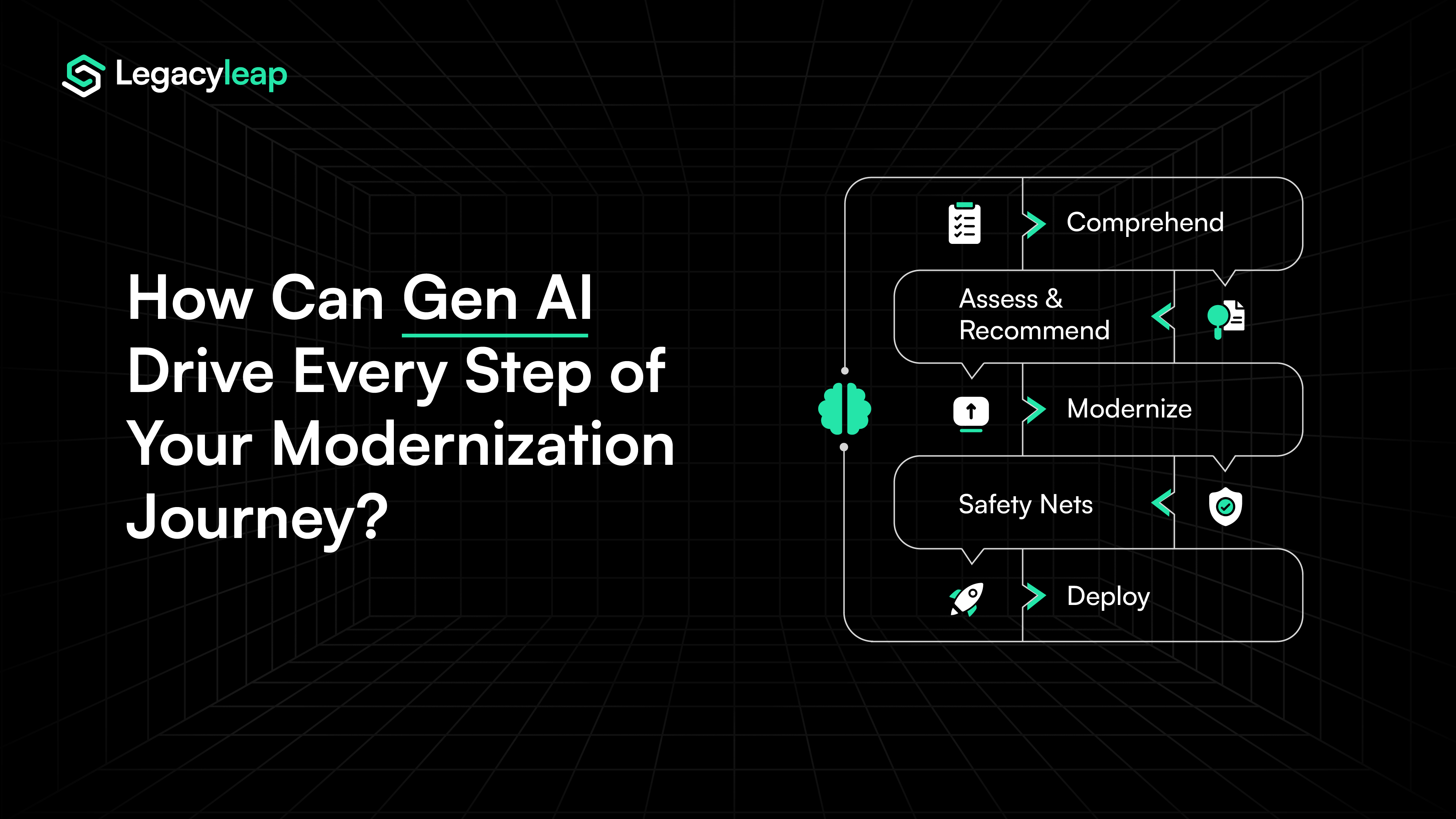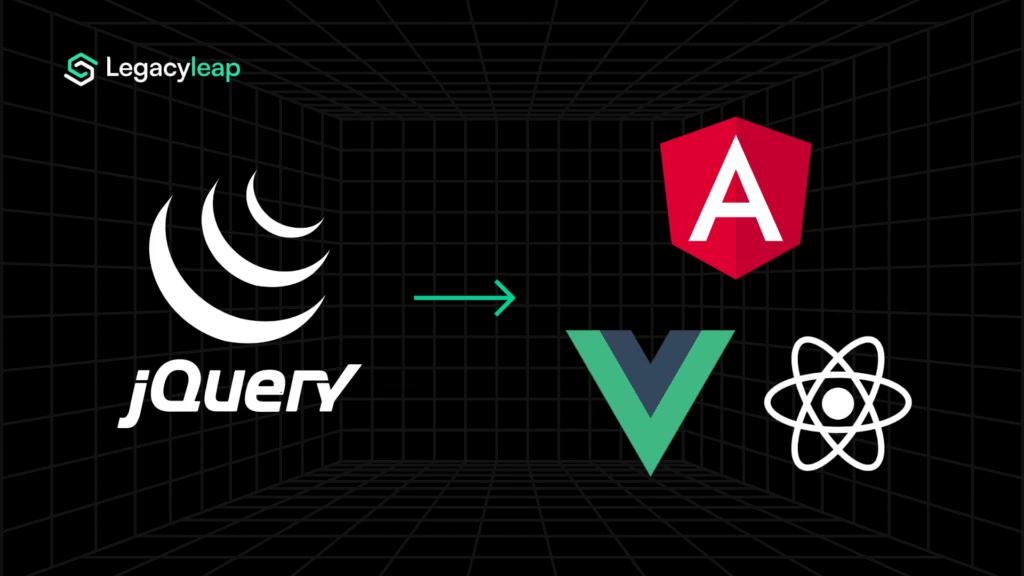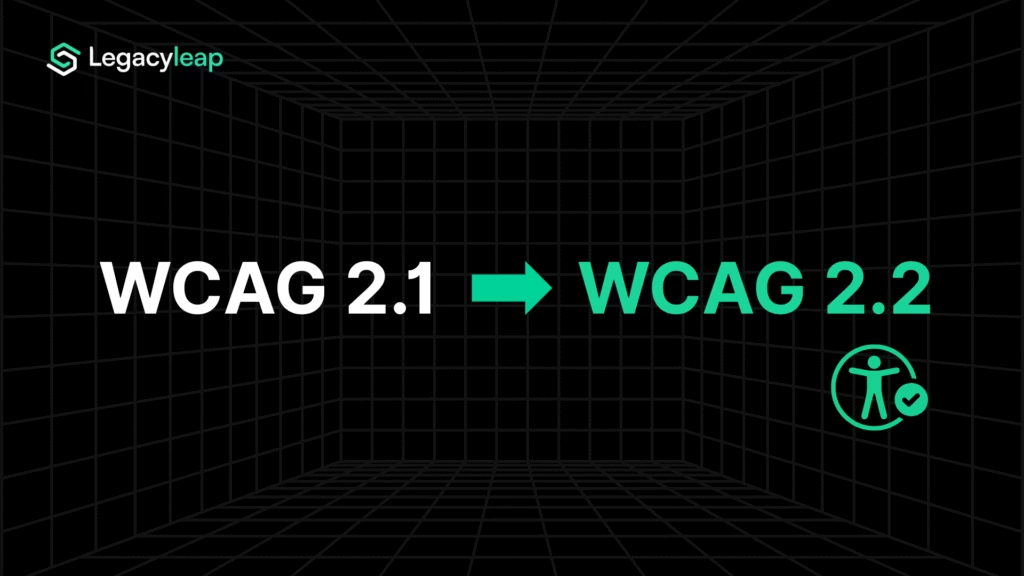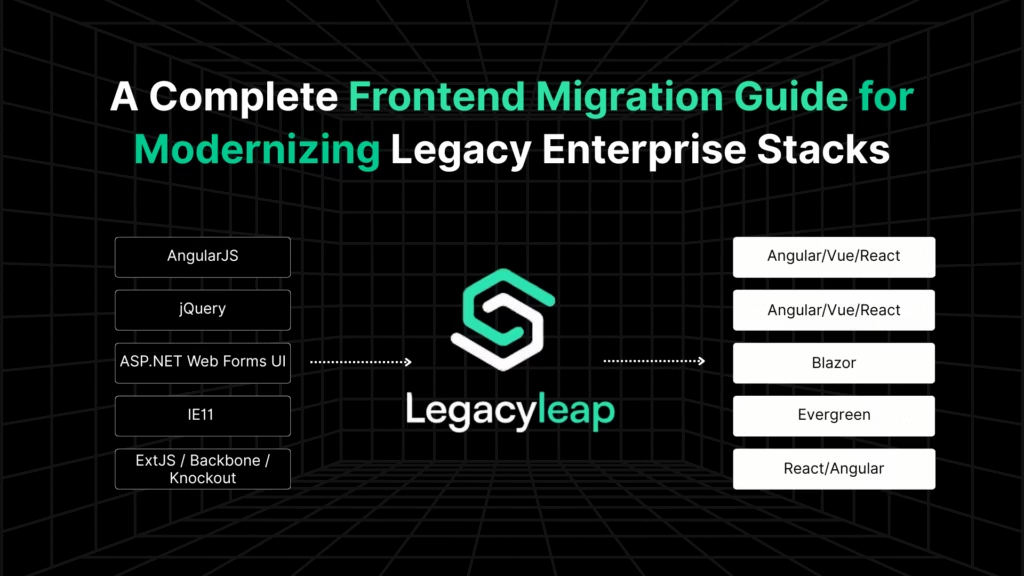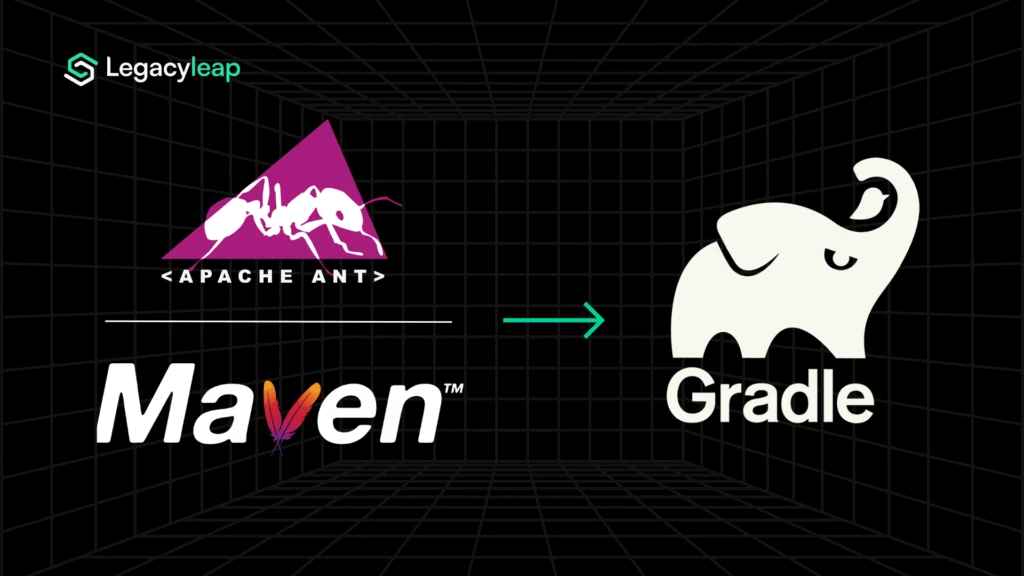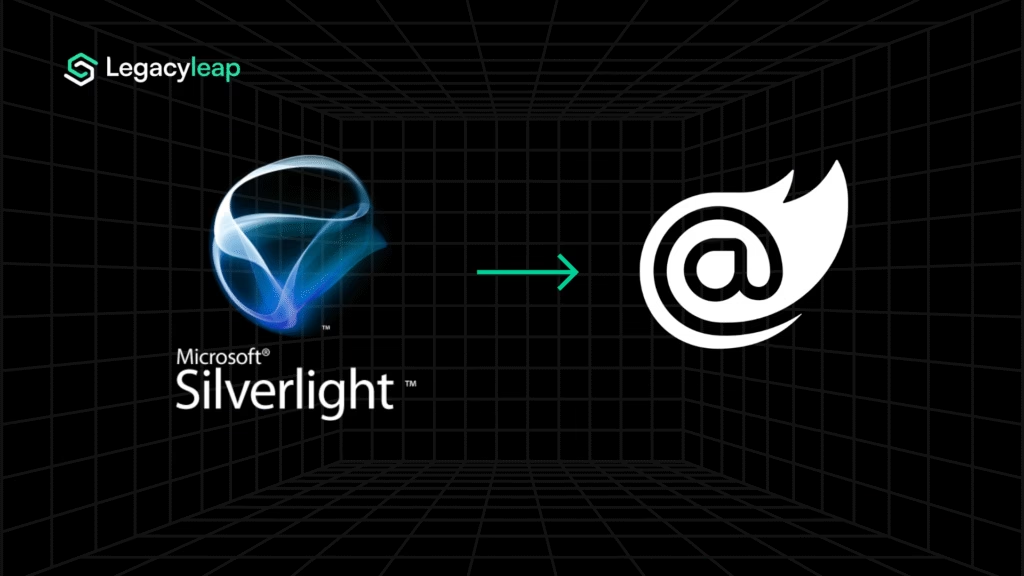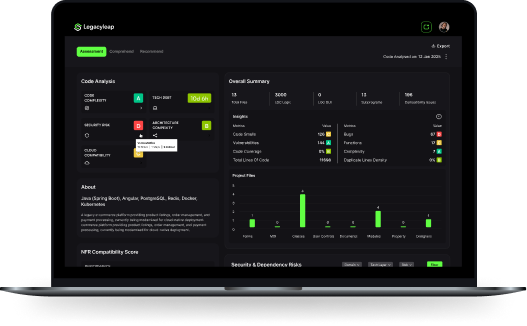Modernizing legacy applications is a critical step for businesses to stay competitive, but the process is often complex, slow, and prone to roadblocks. Traditional modernization methods typically involve long timelines, significant manual effort, and reliance on outdated frameworks.
While these methods can get the job done, they often result in delays, increased costs, and missed opportunities for innovation.
In this blog, we’ll walk you through the five steps of the traditional modernization process—how it’s typically approached without the support of Gen AI.
You’ll also learn why this traditional method falls short and how Legacyleap’s integration of Gen AI at every step makes the process faster, more efficient, and less disruptive.
Let’s begin by examining the classic steps involved in modernizing applications, and why they need a change.
Prefer to listen?
This episode of The Legacy2Leverage Show explores the topic in podcast form.
5 key steps to the traditional application modernization process
We’ve worked on numerous modernization projects over the years and realized that almost all of them involve 5 key steps that we’ll talk about.
- Step 1: Comprehend – Understand architecture, gather stakeholder input
- Step 2: Assess & Recommend – Evaluate legacy assets, code quality, and costs
- Step 3: Modernize – Choose strategy, implement transformation
- Step 4: Safety Nets – Mitigate risk through backups, testing, and planning
- Step 5: Deploy – Roll out updated systems with monitoring and optimization
Here’s an overview of the typical process:
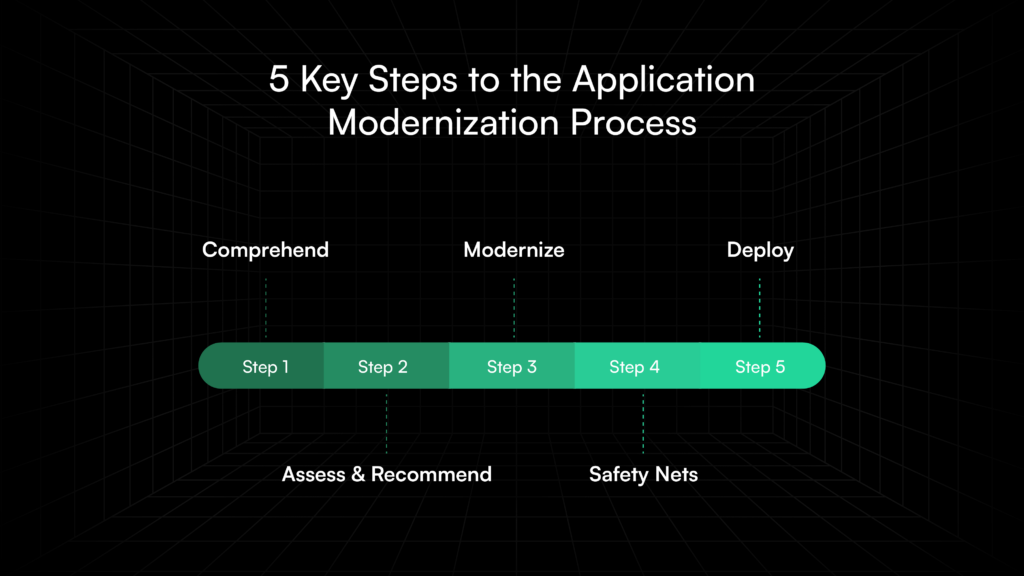
Step 1: Comprehend
Understanding the current state of applications and their alignment with business objectives is crucial. This includes:
- Architecture audit: Reviewing existing systems to pinpoint weaknesses and areas for improvement.
- Stakeholder engagement: Collecting feedback from users and departments to ensure modernization meets business needs.
Step 2: Assess & Recommend
Organizations evaluate their systems to identify what needs modernization, focusing on:
- Inventory of applications: Documenting legacy systems, dependencies, and performance issues.
- Technical debt analysis: Reviewing the codebase for complexity and security concerns.
- Cost-benefit analysis: Weighing the cost of legacy systems against the potential gains from modernization.
Step 3: Modernize
Once assessments are done, organizations move forward with:
- Choosing a modernization strategy: Selecting approaches like rehosting, refactoring, or rebuilding.
- Implementation planning: Creating a roadmap that outlines key milestones and resource requirements.
Step 4: Safety Nets
To minimize risks, safety nets are built around the modernization process:
- Risk management planning: Identifying potential risks and establishing contingency plans.
- Backup solutions: Implementing reliable backup systems to protect data during the transition.
Step 5: Deploy
The final step is deploying the modernized applications:
- Incremental rollout: Gradually implementing changes to reduce disruptions.
- Monitoring and optimization: Continuously assessing the performance of modernized systems to ensure they meet goals.
While these steps provide a structured approach, they can be slow and prone to issues, which we’ll explore in the next section.
Challenges in Traditional Modernization Without Gen AI
While the traditional app modernization process provides a roadmap, each step is fraught with challenges that often lead to delays, increased costs, and failures.
We’ll explore the common obstacles organizations face during each stage now to understand why it’s time to leverage Gen AI to address these issues.
1. Comprehend
- Lack of understanding: Legacy systems are often more complex than they appear, and organizations struggle to grasp the full scope, especially when looking at the overall business and application context. This leads to incomplete assessments of their limitations.
- Insufficient stakeholder engagement: Without involving the right stakeholders early on, organizations risk misalignment between modernization goals and business needs, causing delays or project failure. It also doesn’t help that most documentation is tailored more toward technical folks, which is not always helpful to non-technical stakeholders.
- Inadequate documentation: Many legacy systems were built without detailed documentation, making it hard to understand dependencies and architecture, which hinders proper planning and risk management.
2. Assess & Recommend
- Overwhelming complexity: Legacy systems often involve a tangled web of applications and dependencies, making it difficult to conduct thorough assessments. Key risks or opportunities can be overlooked, delaying the process.
- Resistance to change: Employees’ fear of job loss or workflow changes can lead to inaccurate feedback or incomplete evaluations, slowing down the assessment phase. While this is a lesser-known risk, we think it’s worth mentioning!
- Budget constraints: Limited budgets often force organizations to conduct surface-level assessments, leaving crucial issues unresolved and impeding a clear modernization strategy.
3. Modernize
- Technical debt: High technical debt slows down the modernization process. Refactoring code becomes costly and time-consuming, leading to extended project timelines and budget overruns.
- Skill gaps: The shortage of skilled personnel proficient in both legacy and modern technologies often leads to delays, as organizations scramble to find the right talent.
- Inadequate strategy: Without a comprehensive and aligned modernization strategy, organizations may struggle to execute business priorities, resulting in unfocused and inefficient efforts.
4. Safety Nets
- Underestimating risks: Organizations frequently fail to identify the risks associated with modernization, such as data loss, downtime, or system failures, which lead to significant setbacks during implementation.
- Lack of contingency planning: Without robust backup solutions and recovery plans, any unexpected issues during modernization can spiral out of control, causing delays and data integrity concerns.
- Cultural resistance: Employees often resist new processes or technologies, creating friction and undermining efforts to implement effective safety nets.
5. Deploy
- Incremental rollout challenges: An incremental rollout can be hard to manage without sufficient user training or clear guidelines, leading to disruptions and inefficiencies.
- Monitoring issues: Without proper post-deployment monitoring systems in place, organizations risk missing performance issues that could hinder the effectiveness of the modernized application.
- Poor communication: Inadequate communication about system changes can lead to confusion among users, resulting in poor adoption and inefficiencies that diminish the benefits of modernization.
These challenges highlight the limitations of the traditional modernization process, where inefficiencies, delays, and missed opportunities are all too common. Organizations are often left grappling with complexities, skill shortages, and resistance to change, making it difficult to achieve a seamless and timely modernization.
This is something we’ve actively worked on solving with Legacyleap. We know the frustrations of traditional modernization—the delays, inefficiencies, and missed opportunities.
That’s why we’ve integrated Gen AI into every step, automating tasks, providing real-time insights, and making the entire process smarter and more efficient.
Book a 30 min consultation to see how it works ->
How Legacyleap integrates Gen AI at every step without disruption
At Legacyleap, we saw the challenge of transforming outdated technologies like EJB, VB6, and ColdFusion and knew we could add efficiency to the process. Initially, we tried accelerators, but they didn’t move the needle.
When GitHub Copilot launched in 2021, we were excited, but quickly realized it wasn’t built for complex legacy systems. While it could generate small pieces of code, it couldn’t handle intricate, legacy codebases effectively.

That was the whole idea behind building Legacyleap – a Gen AI-based companion platform purpose-built for modernization.
Our solution helps you assess, comprehend, and generate new applications, while also validating the output. Our differentiator is our approach: we combine Gen AI with sophisticated compiler technologies to understand and represent your legacy code in ways that tools like OpenAI simply can’t.
And most importantly, we integrate Gen AI at every step of the modernization process, without disrupting your existing workflow. This combination allows us to deliver more accurate, efficient, and reliable modernization.

With that said, let’s get into the details!
Real-World Example: Modernizing a 20-Year-Old VB6 System with Gen AI
A leading fuel distribution software company relied on a 20-year-old VB6 application with no documentation and a brittle codebase. Using Legacyleap, the team applied Gen AI to infer business logic, auto-generate layered documentation, translate the code to .NET, and build safety nets through test case generation. What would’ve taken 12 months manually was executed in just 3, proving that Gen AI, when grounded in structure and validation, can modernize even the most fragile systems.→ See the full case study
Step 1: Gen AI for Comprehending Legacy Code
The first step in the modernization journey is comprehension, where Legacyleap goes beyond traditional code analysis tools to provide a deep, insightful understanding of your legacy applications. This step is all about generating comprehensive documentation—both business and technical—that paints a complete picture of the current system.
Here, we generate three key types of documents:
- Business-Oriented Documentation: This document focuses entirely on the business logic. It’s written in plain, functional language—no technical jargon—so anyone, even non-technical stakeholders, can easily understand the purpose and flow of the system.
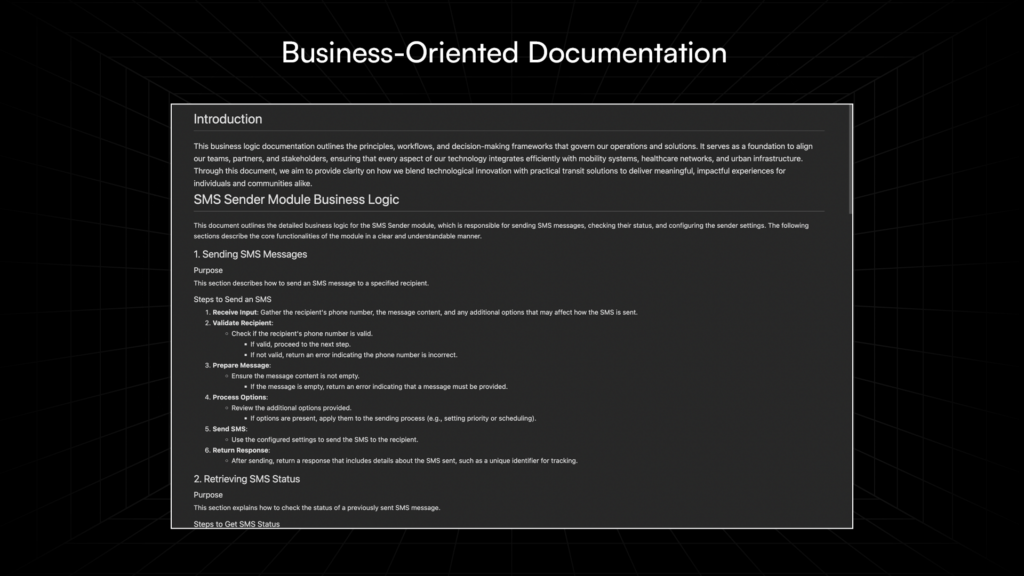
- API Documentation: This is where we dive into the details of the system’s APIs, covering everything from input and output parameters to error codes and methods. It also includes Swagger documentation, offering an organized view of how the system’s endpoints function.
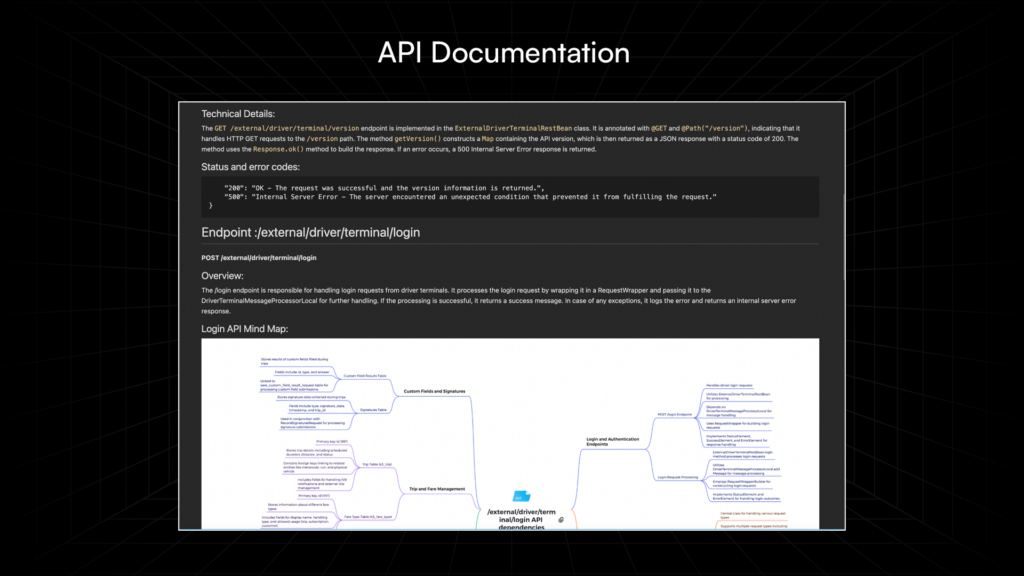
- Technical Documentation: The technical side of things, where we provide low-level insights such as method definitions, inputs, exceptions, and more. Additionally, we generate a mind map of the code base—an overall visual representation that simplifies the understanding of the entire application structure. This allows developers to quickly grasp the architecture without needing to comb through the entire codebase.
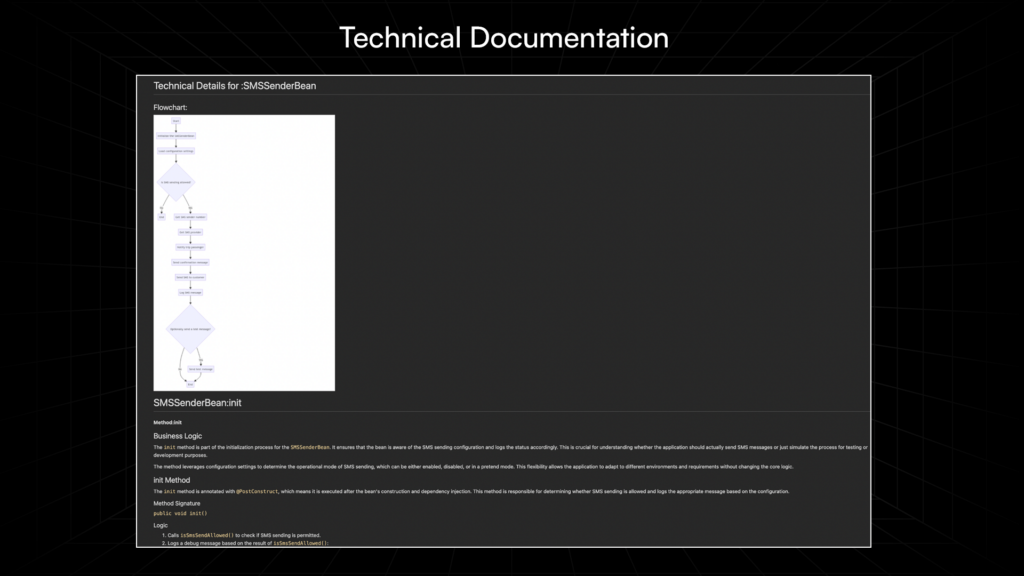
In short, this first step helps you truly comprehend your legacy system, with clear, actionable documentation that lays the groundwork for successful modernization.
Also Read: How Gen AI Helps You Comprehend Legacy Systems Faster
Step 2: AI-Powered Assessment and Code Recommendations
The next step in the process is assessment, where we take a hard look at the current state of your application to identify areas for improvement. This isn’t just about understanding the code’s structure—it’s about evaluating its quality, uncovering hidden risks, and pinpointing where it can be optimized.
Our assessment focuses on two key areas:
- Quality and health of the code: This includes identifying anti-patterns, code smells, and other quality issues that could affect performance and maintainability. We assess cognitive complexity, bugs, and potential security vulnerabilities to provide a full picture of where the code stands.
- Recommendations for improvement: Using advanced Gen AI techniques, we generate actionable recommendations for code improvements. These include suggestions for addressing technical debt, improving the overall structure, and optimizing specific components.
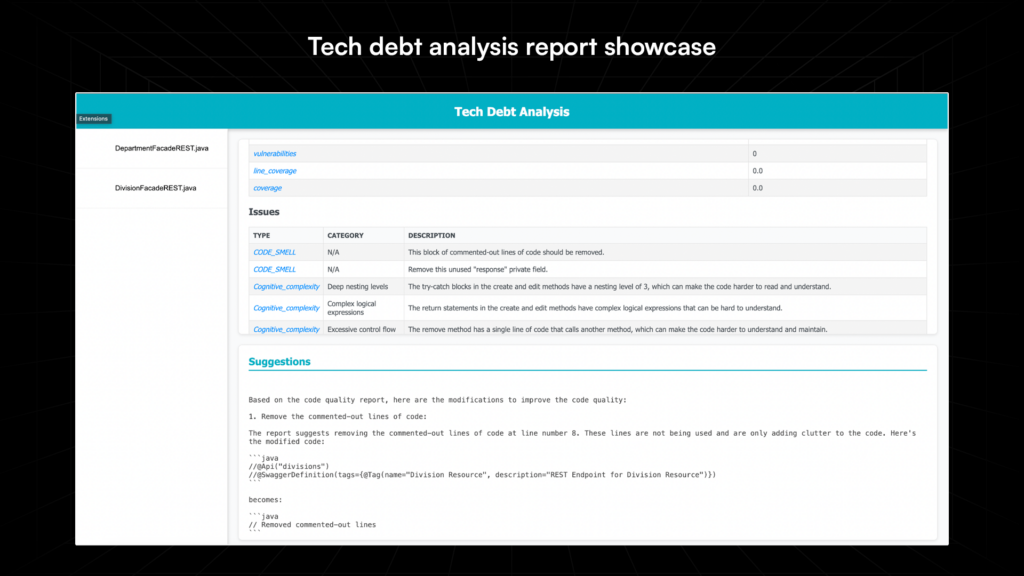
For instance, we may suggest areas where monolithic code can be broken down into microservices—helping you move towards a more modular, scalable architecture.
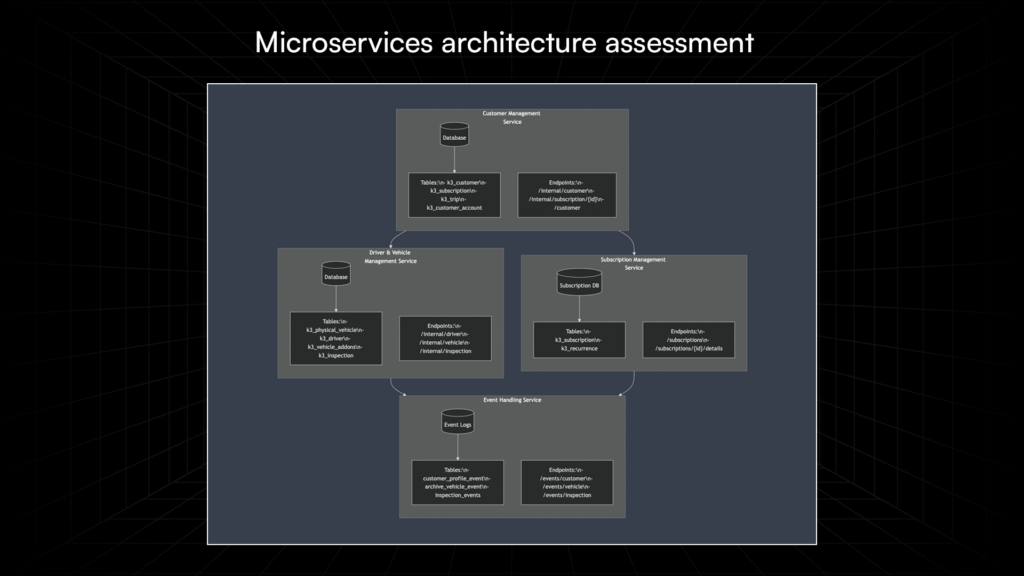
Though we’re still evolving this phase—especially with microservices recommendations—we already deliver significant value in highlighting areas for code optimization and improvement, all backed by AI-driven insights.
This step ensures that your legacy system is ready for transformation, with clear pathways for modernization.
Also Read: How Gen AI Identifies Risks and Opportunities in Legacy Code
Step 3: Gen AI-Assisted Legacy Code Modernization
This step is where we put all the insights and assessments into action, transforming your legacy application into its modern counterpart.
This phase is highly flexible, adapting to the unique requirements of each project—whether it’s a straightforward version upgrade or a comprehensive architectural overhaul.
Here’s how we approach migration:
- Targeted architecture creation: We design a migration strategy based on the desired target architecture, tailored to your specific needs. This could range from a direct upgrade (e.g., EJB2 to Java) to more intricate tasks like breaking monoliths into microservices. The process ensures that the end result aligns perfectly with your modernization goals.
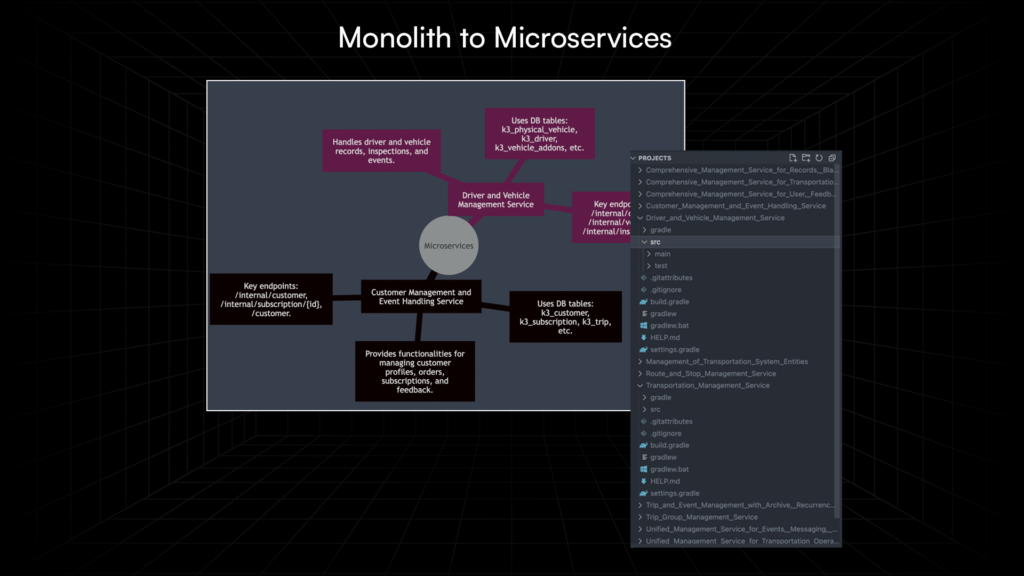
- Layer-by-layer transformation: Whether dealing with EJB-to-Spring migrations or more complex refactoring, Legacyleap automates the conversion of all application layers. From REST endpoints to service layers and database entities, our tools ensure seamless migration while maintaining logical integrity.
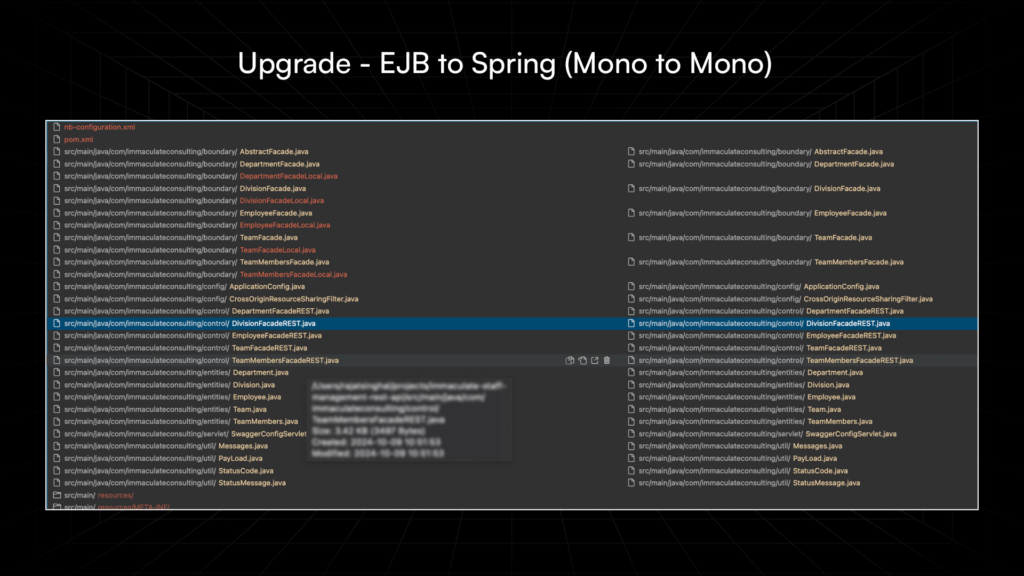
- Architectural revamps: For projects requiring extensive changes, we leverage our Gen AI platform to orchestrate architectural transformations. This could include redesigning legacy systems for microservices or integrating scalable frameworks to future-proof the application.
By automating much of the migration process and combining Gen AI with domain expertise, we not only accelerate the timeline but also ensure accuracy and consistency. This step is where legacy meets innovation, setting the stage for a modern, robust application that is ready to evolve with your business.
Step 4: AI-Generated Tests & BDD Safety Nets
In this step, we focus on ensuring your modernization journey is as risk-free and reliable as possible. This involves creating comprehensive test cases and establishing quality gates that act as safeguards throughout the process.
Here’s what this step entails:
- Automated test case generation: Our platform generates a range of test cases, including API, end-to-end, and unit test cases. These tests ensure that every layer of your application is validated, from business logic to low-level operations.
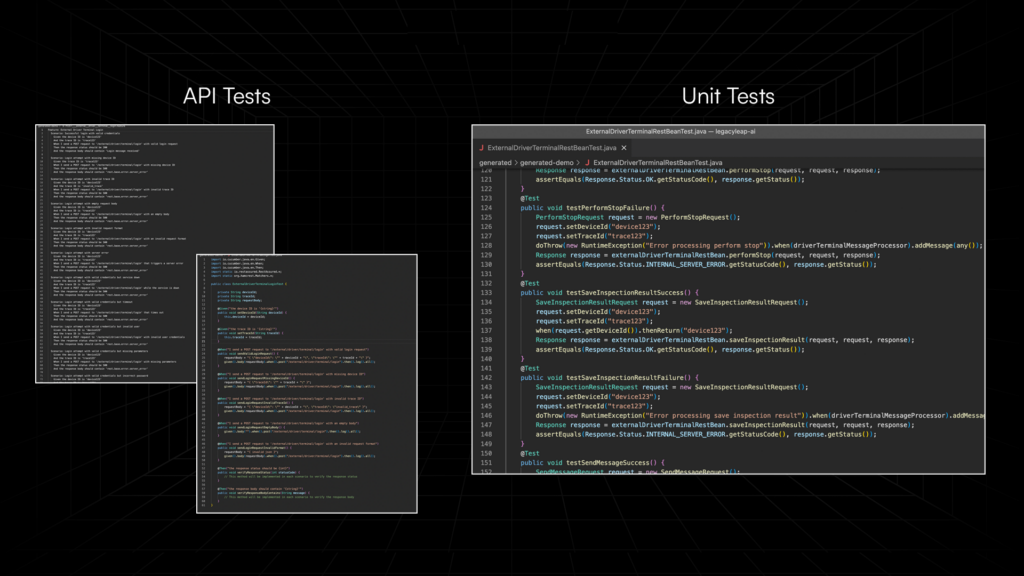
- Behavior-Driven Development (BDD) testing: Test cases are written in a clear, intuitive syntax, such as Gherkin, making them accessible and understandable even to non-technical stakeholders. These BDD-style tests validate functionality while aligning with business requirements, ensuring the application meets expectations.
- Quality gates for progress: These test cases serve as quality gates—critical checkpoints that verify the integrity and performance of the migrated code. By automating this step, we eliminate human error and ensure your modernization effort proceeds swiftly and securely.
By building these safety nets, Legacyleap creates a robust framework for continuous testing and validation. This step guarantees that your newly modernized application not only meets technical requirements but is also resilient and ready for the future.
Also Read: How Gen AI Builds Unbreakable Safety Nets for Modernization
Step 5: Automated Deployment with Gen AI
The Deployment phase marks the final step in the modernization journey, where your transformed application is transitioned to the target infrastructure. Legacyleap ensures this process is seamless, automated, and fully aligned with your deployment goals.
Here’s how this step works:
- Automated artifact generation: Legacyleap generates all necessary deployment artifacts, such as Helm charts for Kubernetes, Terraform scripts for EC2, or serverless configurations. These artifacts are customized based on the infrastructure recommendations and eliminate the need for manual intervention, significantly reducing time and errors.
- Flexible deployment options: Whether it’s Kubernetes, serverless, or traditional VM-based setups, Legacyleap adapts to your infrastructure preferences. It integrates effortlessly with platforms like AWS Bedrock and leverages a modular AI middleware layer to fine-tune deployment strategies based on your specific needs.
- Enhanced governance and monitoring: Deployment isn’t just about getting the application live—it’s about visibility and control. Legacyleap provides interfaces tailored for different stakeholders:
- CLI for batch-oriented tasks like generating deployment reports.
- Custom IDE for development teams, optimized for legacy modernization tasks.
- Web UI for business leaders to monitor progress, access reports, and ensure alignment with strategic goals.
- Privacy and security by design: The platform operates entirely within your enterprise-owned infrastructure, ensuring no code or sensitive information leaks beyond your organization’s firewall. For older technologies, it uses fine-tuned AI models to enhance deployment reliability without compromising security.
With Legacyleap, deployment is more than just the final step—it’s a fully integrated process designed to ensure your modernized application is up and running, and ready to deliver value from day one.
Also Read: How to Use Gen AI to Achieve Efficient Modernization Deployment
Modernization is a puzzle, Gen AI is the missing piece
Modernization has long been seen as a technical necessity, and the integration of Gen AI has really broadened its feasibility. It goes beyond automation, augmenting human decision-making by accelerating processes like documentation, microservice identification, and deployment pipeline creation.
Gen AI’s adaptability to new codebases, languages, and architectures ensures a future-proof approach, keeping your modernization efforts relevant as technology evolves.
Rather than replacing developers, Gen AI empowers them, handling complex, repetitive tasks and freeing up teams to focus on innovation, user experience, and business outcomes. As it transforms how organizations modernize, the potential of Gen AI is only beginning to unfold.
As Gen AI becomes an integral part of the modernization journey, the possibilities are only beginning to unfold. The question isn’t whether to integrate AI—it’s how to maximize its potential.
Your Next Step: Consider how Gen AI could redefine your approach to legacy systems. Are you leveraging its full potential to modernize faster, smarter, and with greater impact? Now is the time to rethink what’s possible.
Learn how Legacyleap is genuinely redefining modernization with Gen AI—visit our website to explore our solutions.


